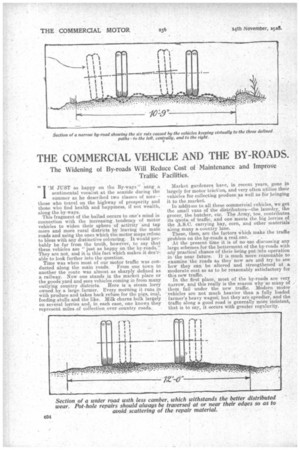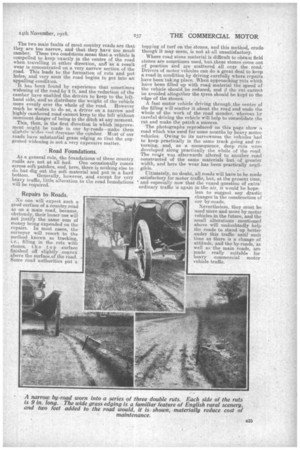THE COMMERCIAL VEHICLE AND THE BY-ROADS.
Page 14

Page 15

If you've noticed an error in this article please click here to report it so we can fix it.
The Widening of By-roads Will Reduce Cost of Maintenance and Improve Traffic Facilities.
I
" 'M JUST as happy on the By-ways" sang a
sentimental vocalist at the seaside during the summer as he described two classes of men— those who travel on the highway of prosperity and those who find health and happiness, if not wealth, along the by-ways. This fragment of the ballad occurs to one's mind in connection with the increasing tendency of motor vehicles to widen their sphere of activity and tap more and more rural districts by leaving the main roads and using the ones Which the motor maps refuse to bless with any distinctive colouring. It would probably be far from the truth, however, to say that these vehicles are "just as happy on the by-roads." They are not, and it is this fact which makes it des7rable to look further into the question.
Time was when most of our motor traffic was conducted along the main roads. From one town to another the route was almost as sharply defined as a railway. Now one stands in the market place or the goods yard and sees vehicles coming in from many outlying country districts. Here is a steam lorry owned by a large farmer. Every morning it runs in with produce and takes back refuse for the pigs, -coal, feeding stuffs and the like. Milk churns bulk largely on several lorries and, in each case, one knows they represent miles of collection over country roads. Market gardeners have, in recent years, gone in largely for motor traction and very of-ten utilize their vehicles for collecting produce as well as for bringing it to the market.
In addition to all these commercial vehicles, we get the small vans of the distributors—the laundry, the grocer, the butcher, etc. The Army, too, contributes its quota of traffic, and one meets the big lorries of the A.S.C. carrying hay, corn, and other materials along many a country lane.
These, then, are the factors which make the traffie problem on the by-roads area!one. At the present time it is of no use discussing any large schemes for the betterment of the by-roads with any practical chance of their being put into operation in the near future. It is much more reasonable to examine 'the roads as they now are and try to see how they can be altered and strengthened at a moderate cost so as to be reasonably satisfactory for this new traffic.
In the first place, most of the by-roads are very narrow, and this really is the reason why so many of them fail under the new traffic. Modern motor ' vehicles are not much heavier than a fully loaded farmer's heavy wagon, but they are speedier, and the traffic along a good road is generally more insistent, that is to say, it occurs with greater regularity. The two main faults of most country roads are that they are too narrow, and that they have too much camber. These two conditions mean that a. vehicle is compelled to keep exactly in the centre of the road when travelling in either direction, and as a result wear is concentrated on a very narrow section of the road. This leads to the formation of ruts and pot holes, and very soon the road begins to get into an appalling condition.
It has been found by experience that sometimes widening of the road by 2 ft, and the reduction Of the camber have enabled the. drivers to keep to the lefthand side, and so distribute the weight of the vehicle more evenly over the whole of the road. However much he wishes to do so, a driver on a narrow and highly Cambered road cannot keep to the left without imminent danger of being in the ditch at any moment. This, then, is the first direction in which improvement might be made in our by-roads—make them slightly w;ley .,er1 rlecrease the camber. Most of our roads have substantial grass edging so that the suggested widening is not a very expensive matter.
Road Foundations.
As a general rule, the foundations of these country roads are not at all bad. One occasionally comes across soft patches, and, here, there ia nothing else to do but dig out the soft material and put in a hard bottom. Generally, however, and except for very heavy traffic, little alteration to the road foundations will be required.
Repairs to Roads.
No one will expect such a good surface of a country road as on a main road, because, obviously, their lesser use will not justify the same sum of money being expended on the repairs. In most cases, the surveyor will resort to the method known as tracking, i.e., filling in the ruts with stones, the top surface finished off slightly convex above the surface of the road. Some road authorities put a topping of turf on the stones, and this method, crude though it may seem, is not at all unsatisfactory.
Where road stone material is difficult to obtain field stones are sometimes used, -but_these stones come out of position rind are scattered all over the road.' Drivers of motor vehicles can do a great deal to keep a road in condition by driving carefully where repairs have been taking place. When approaching ruts which have been filled up with road material the speed of the vehicle should be reduced, and if the rut cannot be avoided altogether the -tyres should be kept to the edge of the stones. A fast motor vehicle driving through/the centre of the filling will scatter it about the road and undo the whole of the work of the road mender, whereas by careful driving -the vehicle will help to consolidate the rut and make the patch a success.
The photographs reproduced • on this page • show a road which was used for some months by heavy motor vehicles. Owing to its narrowness the. Vehicles had to keep practically in the same track going and returning, and, as a consequence, deep ruts were developed along practically the whole of the road. The rote was -afterwards altered to another road constructed of the same materials but of greater width, and here the wear has been practically negligible. Ultimately, no doubt, all roads will have to be made satisfactory for motor traffic, but, at the present time, ' and especially now that the vexed question of extraordinary traffic is again in the air, it would be hopeless to suggest any drastic changes in the construction of our by-roads.
Nevertheless, they .must be used More and more by motor vehicles in the future, and the small alterations mentioned above will undoubtedly help the roads to stand -up better under this traffic until such time as there is a change of attitude, and the by-roads, as well as• the main roads, are made really suitable for heavy commercial motor vehicle traffic,






















